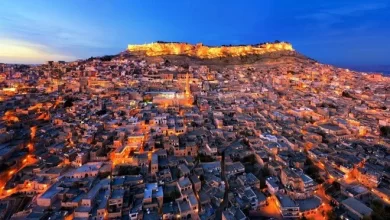Deyrulzafaran Monastery, Mardin

Deyrulzafaran Monastery is one of the unique structures overlooking Mesopotamia in the magical land of Mardin. This monastery, which is 4 km away from the city center, is also called the Syriac masterpiece. If you go to Deyrulzafaran at sunset, you can see the colorful states of the Mesopotamian Plain flirting with the sun and feel all the values that make Mardin different. Well, what is the ancient story of this monastery, which has had its share of the flamboyant history of a stone mountain city, and what awaits you while you tour?
What Does the Name Deyrulzafaran Mean?
The courtyard of the monastery, which is reached by passing through a garden full of centuries-old plane and olive trees, is connected with the cities in the fairy tales. You are included in this fairy tale with the mystery of Mesopotamia, its inviting energy and the yellowish stone color that caresses your eyes when you go. It must have been inspired by the color of these stones, Deyrulzafaran’s Syriac word meaning is yellow. However, there are those who say that the saffron plant (zafaran) that grows around it can contribute to this name.

Historical Significance of Deyrulzafaran Monastery
The monastery has 3 floors and dates back to the 5th century. However, the area where it was built is Umbrellas, which is a sun temple used for 4 centuries by the peoples who worship the sun. The Romans used this place as a castle in later periods. When the Romans withdrew from the castle, St. Sleymun brought the bones of the graves of the deceased saints here and turned the castle into a monastery. The restoration of the structure, which was known as the Mor Sleymun Monastery for a long time, was started in 793 during the reign of St. Hananyo. After this renovation, it changed its name and became known as Mor Hananyo Monastery. It got its current name in the 15th century, and its final form in the 18th century with additions.
Deyrulzafaran Monastery, which has both historical and religious importance, is almost like a Mecca for Assyrians scattered all over the world. So much so that for 640 years, this was the patriarchate center of all Assyrians in the world. After 1932, the headquarters of the Patriarchate was first moved to Homs and then to Damascus. The monastery was used not only for worship but also for education, and the first printing house in the region was established here. Peter 4, one of the monastery’s 19th-century patriarchs, was greatly reformed. The printing of dozens of books in Syriac, Ottoman, Arabic and Turkish, which started during his reign with the printing house he bought from England, continued until 1969. Here you can see some parts of the printing house that has been retired for 50 years… monastery and some in Kirklar Church.

What Else Will You See in Deyrulzafaran Monastery?
It must be one of the beauties evoked by the prayers inside, each temple has a different definition of peace. Deyrulzafaran Monastery is one of the places where peace is high. The courtyard of the monastery is a magical realm in itself and you can feel the eternal mystery of Mesopotamia that connects the sky and the earth. The Syriac inscription on the giant entrance door of the courtyard means that he came with faith. The priest with his long rosary, the more you come across this inscription and the high black cloak, the better you realize that you are visiting an active place of worship rather than a historical artifact.
The Monastery Divided Within Itself;
These sections are the Domed Church, also called Mor Hananyo, the Virgin Mary Church, the House of Saints and the Sun Temple. The monastery, which is the most surprising place for visitors, also has the tombs of 52 Syriac patriarchs.

Mor Hananyo Church: Byzantine Period A.D. It was built in 491-518 by two Assyrian brothers who were architects. The most striking aspect of the structure, which is called the Domed Church because its dome is in the shape of a cross, is the animal figures engraved on its outer walls. Inside were frescoes adapted from scripture, but with one exception, St. All the frescoes depicting Hananyo have succumbed to time. One of the two lecterns in the main apse of the church is 350 years old and wooden. The other is made of ivory and is said to be 500 years old. These two lecterns were used by all patriarchs corresponding to their periods.
House of Saints (Beth Kadise): Located in the southeast of the monastery, this building has the same history as the monastery and dates back to the 5th century. The latest renovation is Patriarch IV. It was built in 1884 at the time of Peter. The corpses of the patriarchs of the monastery and some saints are also in this church. There are a total of 52 graves in 7 graves, including the cleric who was buried in 1969. The most important feature that will make this section, and even the monastery, unforgettable is that the clergy of Hz. ceremonies. sitting position facing east. The Assyrians believe that Saint Jesus will come from the east on the day of his resurrection and hope to meet him. Another feature of the church is the stone engravings you will see on its interior walls. Embroidery such as a cross surrounded by dolphins, vase figures with flowers and bunches of grapes is like an art story spanning centuries. Maybe because of the snake motifs on the walls of the building, it is among the rumors that it was used in medicine in ancient times.

Church of the Virgin Mary: When you enter the courtyard, it is the building in the northeast and is the first church of the monastery. The baptismal stone, which is estimated to be 1500 years old and is no longer used and only exhibited, is like the symbol of this section. The church covers an area of 153 square meters. Among the most interesting places, St. There are Syriac verses on the 3 wooden doors believed to have been written during the David period. You can also see some parts of the printing house used in the past here.
It is estimated that the age of the Temple of the Sun coincides with the period when Mardin was first established, that is, before Christ. And you meet him at the eastern corner of the Mor Hananyo Church in the monastery. The ceiling of the temple, where the Assyrians worshiped the sun before they became Christians, was made without mortar and the stones were leaning against each other. It was worshiped until the light from the room’s tiny window disappeared, and sacrifices were offered to the sun on the altar. There are also opinions that this victim is a human and you tremble a little when you think about it while walking.






